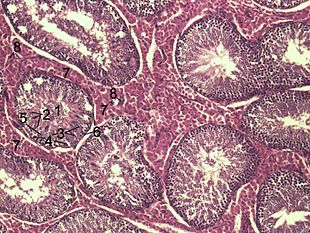Spermatogonium
Spermatogonia (singular spermatogonium or spermatogonia ), also primitive sperm cells , are the stem cell population in the germinal epithelium of the testicle . These tissue-specific stem cells, which are determined to develop into sperm cells, arise from primordial germ cells after they have migrated into the testicular system in the course of an initial mitotic cell division during spermatogenesis . They are found in the basal section of the germinal epithelium directly on the basement membrane and have a roundish cell nucleus rich in chromatin . In contrast to egg cells , which no longer multiply, spermatogonia can multiply and thus form new starting populations for spermatogenesis.
1) Lumen of a convoluted seminiferous tubule
2) Spermatids
3) Spermatocytes
4) Spermatogonia
5) Sertoli cells
6) Myofibroblasts
7) Leydig cells
8) Capillaries
research
Scientists have succeeded in rejuvenating spermatogonia from the testes of adult men under the influence of a growth factor and an inhibitor into pluripotent cells, which can therefore transform into any cell type in the body. Experiments have shown that these germline stem cells reprogrammed in this way meet all molecular biological and functional requirements that are also placed on human embryonic stem cells (ES cells). This evidence is now controversial and the authors of the study have withdrawn their manuscript.
Individual evidence
- ↑ Sabine Conrad et al .: Generation of pluripotent stem cells from adult human testis. In: Nature. No. 456, November 20, 2008, pp. 344-349, doi : 10.1038 / nature07404 .
- ↑ Sabine Conrad et al .: Retraction: Generation of pluripotent stem cells from adult human testis In: Nature. No. 512, August 31, 2014, doi : 10.1038 / nature13661 .

